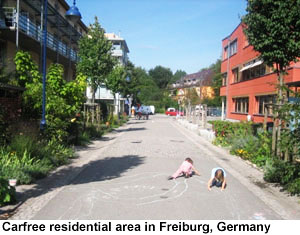
At the beginning of the 20th century, enlightened urban planners created garden cities and suburbs to improve working people's health

FRONT PAGE
Site Search
About us
 

Urban planning and public health
South Asians face health risk in urban UK
Health in growth cities
Health care in the US
Black barbershops
Health in Asian cities
Urban slums

Worldwide | Elections | North America | Latin America | Europe | Asia | Africa |


























|
|
Urban planners must make
public health main priority
By Alan Kent*
25 July 2012: As our society changes and develops, so too does our urban environment and the process of urban planning is, at present, in a state of flux. Central to the objectives of future planning needs to be an emphasis on public health. Urban planning and public health have long been intertwined, so intrinsically is human environment linked to well being.
On a very basic level, the design and development of habitation is based on fundamental human needs: shelter, protection from nature and proximity to food. Historically, planning of urban areas has taken into account the hierarchy of society, the need to manoeuvre goods and access to materials and resources. Communities have traditionally included and often been based around centralised meeting places such as squares, market places and religious buildings.
During the 1800s, there began to be more emphasis on the health of citizens as importance started to be placed on sanitation. Sewer and waste systems became more efficient for the avoidance of germs and disease and this radical redesigning of cities dramatically improved life expectancy and standards of living. More recently, the public health sector has recognised that a healthy person is not simply someone who is immunised and avoids disease, but also someone who does not suffer from abuse or neglect. As a result, emotional and psychological health has been given more emphasis. Complete health is deemed a human right that everyone should have access to and must be taken into to account as a whole when teaming public health with urban planning.
During the Industrial Revolution, workers flooded away from farms and into the cities for work, there was overcrowding and lack of adequate light and ventilation, which lead to typhus and cholera. Similarly, today’s population is growing and around 80 per cent of the world’s population live in urban areas, creating a massive strain on resources. Increasing human reliance on the use of cars and the internet means that many geographical barriers of the past do not exist anymore; advancements in infrastructure and communication have lead to massive migration and diverse cities full of different cultural communities.
This causes two considerations for urban planning and public health: firstly, communities segregate themselves according to ethnicity or religious belief and begin to dictate their own set up and secondly, there is an increasing gap between rich and poor, with poor communities not getting access to adequate living standards. People’s socioeconomic status affects where and how they live which directly affects their health and standard of living. Planners must consider the demands and needs of the people they are building for and complete health must be centre to the process for all communities. What is more, bad living conditions link to anti social behaviour and crime. Lessons must be learnt from previous attempts at urban re-designation. In the past, ‘slum clearing’ measures, aimed at better use of urban space, included moving communities into high tower blocks. This was broadly a failure in health terms, leading to loneliness, isolation and higher crime rates.
 Safety and diversity in living environments is crucial for people’s enjoyment of them, their benefits to be appreciated and consequently, for public health. Public spaces and centralised meeting places must be clean, accessible, visible, well lit and appealing to a mix of demographics so that citizens feel inclined to use them. Good quality public spaces promote communication and exercise and help to prevent violence, isolation breakdown or segregation of communities and the damage to public health. Safety and diversity in living environments is crucial for people’s enjoyment of them, their benefits to be appreciated and consequently, for public health. Public spaces and centralised meeting places must be clean, accessible, visible, well lit and appealing to a mix of demographics so that citizens feel inclined to use them. Good quality public spaces promote communication and exercise and help to prevent violence, isolation breakdown or segregation of communities and the damage to public health.
It is crucial that urban planners recognise the importance of well maintained facilities: libraries, green spaces, health services, schools, as well as adequate housing that is not repetitive in design and rather can be characterised by the community giving a feeling of ownership, responsibility and pride. Potentially damaging factors must also be considered and regulated, such as the availability of alcohol, drugs and firearms. Investment into neighbourhoods and communication with communities to ascertain their needs, whether in cities or suburbs, greatly heightens living standards, mental and social health.
Additionally, managing CO2 emissions is integral to urban planning and health. Exploring cleaner public transport options and more pedestrian and bicycle friendly routes are a step in the right direction. With more and more of the population spending a high percentage of their day indoors - in work spaces and schools - the design of the insides of buildings must be considered in terms of their effect on public health.
In order to create living environments that are conducive to sustainable and complete health, urban planning must be based on the environmental requirements dictated by technological advancements and take place with the needs of each community in mind.
Alan Kent is passionate about urban planning and works for UK concrete street furniture supplier, Bomax, who recently worked with LOCOG on the London Olympic Park.
|
|

|


































 Safety and diversity in living environments is crucial for people’s enjoyment of them, their benefits to be appreciated and consequently, for public health. Public spaces and centralised meeting places must be clean, accessible, visible, well lit and appealing to a mix of demographics so that citizens feel inclined to use them. Good quality public spaces promote communication and exercise and help to prevent violence, isolation breakdown or segregation of communities and the damage to public health.
Safety and diversity in living environments is crucial for people’s enjoyment of them, their benefits to be appreciated and consequently, for public health. Public spaces and centralised meeting places must be clean, accessible, visible, well lit and appealing to a mix of demographics so that citizens feel inclined to use them. Good quality public spaces promote communication and exercise and help to prevent violence, isolation breakdown or segregation of communities and the damage to public health.